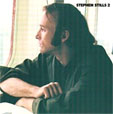
Stephen Stills (1969)The late 60s and early 70s saw the proliferation of solo projects by members of famous bands. Dave Mason, late from Traffic, produced one of the most memorable solo records from the era, called Alone Together. Each of the Beatles tried their hand at solo albums, often with wildly uneven results. One of the earliest solo recordings to scale the charts was Stephen Stills' first solo effort. At first glance, it seems that the impetus for this project came from equal parts soaring self confidence, a desire for more artistic control from his current band mates, Crosby, Nash, and Young, and as an outlet for a hugely creative period in Stills' life. It now seems evident, especially in view of the 2007 release of Just Roll Tape--the 1968 demo Stills recorded following a session for Judy Collins--that Stills had indeed amassed a considerable repertoire of completed material and half-finished ideas, most of which would end up on his solo records. It is well documented that record companies are often leery of solo projects, primarily because Something of a bookend to 4 + 20, Do For the Others is both contemplative and moving in its depiction of a rejected lover finding no solace in the world of a "lonely town." It features Stills as folk singer, alone with a guitar, playing a simple arrangement with only a bass, shaker, and second guitar overdub. At this time in his career, Stills could navigate the sometimes dangerous waters of honesty and emotion without becoming maudlin. There are other standout songs. In Church, Stills cuts loose like an evangelist at a revival meeting, demonstrating some of his most soulful vocal chops, leading a gospel choir through each chorus. Cherokee--supposedly Stills' plaintive cry for Rita Coolidge--delivers a deep, progressive jazz groove in 7/4 time signature. The tune is chocked full of great performances, including Booker-T's haunting organ, sweet alto sax and flute solos, and Stills playing lead fills on an electric sitar guitar. With a better horn arrangement, the song would have been a masterpiece. (So many artists of this period--eager to attempt what Chicago and Blood, Sweat & Tears were doing so effectively with wind and brass instruments--made the same gaffs trying to superimpose horns into their rock format. Remember The Doors' Soft Parade?) Three of the most popular album-oriented radio cuts from the album were Old Times, Good Times, Think I'll Go Back Home, and Black Queen. OTGT does have Jimi Hendrix playing lead guitar, which at first blush sounds like a grand idea. But Hendrix's performance seems cautious and constrained, perhaps because of Stills' tight arrangement and an organ part that kind of washes over everything. As if there were any doubters, Black Queen demonstrates once and for all that Stills can work magic with an alternate tuned acoustic guitar, bending and hammering notes like the best Mississippi blues men. Think I'll Back Home is really just a jam session between Stills and Eric Clapton. Again, the guest guitarist sounds uninspired somehow, while Stills lays out sweet guitar fills charged with his expert wah-wah pedal technique. Much has been written about the packaging of this solo record and an apparent interpretation that Stills is on an ego trip. Regarding the packaging, I personally love the mysterious plush giraffe sitting next to Stills in the snow and find nothing offensive about Stills as a football jersied equestrian. (He loves sports and grew up around horses.) And to answer the critics of this record, a solo effort (whether it's Paul McCartney, Robert Plant, Steve Winwood, or Stephen Stills) is by its very nature going to be self-indulgent. But in all fairness, I think Stills was experiencing a particularly rich creative period in his life and he sought quite successfully to get it down on record. Let's save the ego issues for his next solo LP. Stephen Still 2 (1970)Though much less consistent and offering a handful of complete misfires, Stills' second solo album Then there's the power-ballad Sugar Babe (mystifyingly not a hit), with its high-decibel distorted bass notes, Stills' emphatic gospel-tinged vocals, Hammond organ, and piano, and Dallas holding it all together. The song is Stephen Stills laying out everything he's got in 4 minutes. The song has so many moments you just wait for, like the ascending power chords on piano preceding the final verse. Singin' Call, played in the same modal tuning and contemplative mood as Deja Vu's 4 + 20, is another strong cut, although one feels that the production is a little rushed, just missing that perfectionist's touch that ebbs when Stills produces on his own. But with the artist's signature high-string acoustic riffs over droning E-strings, the song drifts along as if echoing through a river canyon, recounting the singer's white-water rafting experience. In the final verse, Stills switches the imagery to a horse-back trek through the desert and so beautifully articulates his awe at the natural world.
Then there are the songs that don't quite work for one reason or another. Nothin' to Do But Today sounds just like that--that Stills had nothing particularly inspiring to do, so he noodled around with his electric guitar. Know You've Got to Run is another retread of an earlier song fragment from Deja Vu's Everybody I Love You. Frankly, it works better in this guise--a folk song supported by modal-tuned guitars, banjo, and a rumbling bass. Stills, always astute at building musical drama, introduces each instrument with each verse. Fishes and Scorpions had great potential, but its merits are not fully realized. Even with Eric Clapton's signature lead, the bridge is lost in a wave of volume and reverb that masks the nuances of Clapton's and Stills' performance. The song itself is really quite excellent, with the lyrics reflecting the pseudo science of astrology.
Relaxing Town finds Stills at his worst--and his best. We cringe when we hear these lines from the first verse:
Perhaps losing some perspective here on his obvious fame, Stills does infuse Relaxing Town with high-octane rock, getting controlled amp feedback and executing his signature whammy technique, particularly in the song's intro. The solo is intense and almost out of control, but that's why it works here. More than anything else, Stephen Stills 2 shows that when Stills is leading the show, he sometimes doesn't make the best creative judgments. Conversely, when serving the role of co-producer and musical arranger as he did on CSN and Deja Vu, the outcome could be absolutely stellar. On those projects, he was one of three or four creative voices, and somehow that arrangement served him and Crosby, Nash, and Young as well. We know from the excellent biography, Crosby, Stills & Nash, that Stills followed release of this album with an ill-fated tour that was marred by a fair amount of alcohol consumption and ragged performances, but this was a low point from which Stills would emerge to deliver his masterwork--Manassas.
|
 they don't tend to chart nearly as well as group albums. Imagine Atlantic's surprise when Stephen Stills reached #3 on Billboard's album charts and the single Love the One You're With peaked at #14. Here you have Stills playing numerous instruments in the studio, including steel drum, Hammond B3 organ, piano, bass, guitar, even vibes (on Drawn to a Flame). And, with the exception of We Are Not Helpless, with its "America's Children" rant, most of the cuts are pretty darn good. Here are some highlights:
they don't tend to chart nearly as well as group albums. Imagine Atlantic's surprise when Stephen Stills reached #3 on Billboard's album charts and the single Love the One You're With peaked at #14. Here you have Stills playing numerous instruments in the studio, including steel drum, Hammond B3 organ, piano, bass, guitar, even vibes (on Drawn to a Flame). And, with the exception of We Are Not Helpless, with its "America's Children" rant, most of the cuts are pretty darn good. Here are some highlights: has some true gems. It could be that his stockpile of new material was beginning to run dry, but songs like Change Partners (first demoed ~1968) represent this musician at his best. The song's cynical theme of ballroom etiquette had to be way outside the mainstream, but the song's soaring melody and killer chorus made this a choice cut on album-oriented rock stations. One of rock's best hired guns, Jerry Garcia, once more lays down a heart-wrenching pedal steel part, while Stills plays 6-string and does his best Floyd Cramer on piano. Dallas Taylor's drums accentuate the rhythm of the song as it moves seamlessly between waltz-time and 4/4.
has some true gems. It could be that his stockpile of new material was beginning to run dry, but songs like Change Partners (first demoed ~1968) represent this musician at his best. The song's cynical theme of ballroom etiquette had to be way outside the mainstream, but the song's soaring melody and killer chorus made this a choice cut on album-oriented rock stations. One of rock's best hired guns, Jerry Garcia, once more lays down a heart-wrenching pedal steel part, while Stills plays 6-string and does his best Floyd Cramer on piano. Dallas Taylor's drums accentuate the rhythm of the song as it moves seamlessly between waltz-time and 4/4. 